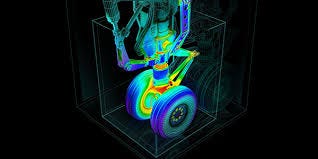Engineering Simulations- A Paradigm

Being an apprentice mechanical engineer, I always wonder how the theoretical concepts learned in the classroom being applied in real life. What impact do they cause? How do you analyse them? Is building prototypes for testing is a feasible option for the MNC’s? These are some of the questions which you might thought of it at some point. Simulations or virtual testing (layman’s term) have start around 1960’s when the companies thought the cost of making prototypes and testing and retesting, it was a laborious task and also not feasible economically . Then the things started to take a leap, the concept of testing virtual came into the picture, now we have many options, software's make your task simple (evaluating behind the curtain) it’s just matter of clicking buttons and end up getting your results.
It is important to note just by clicking buttons and getting fancy contours doesn’t make your true engineering analyst. One who is simulating (tests) must know what’s going behind the curtains and also one must also be aware of interpreting the results. Clicking buttons, garbage-in and garbage-out doesn’t work in industries, as simulations play an crucial part in design process of a product. Any alterations may cost a lot for the company, so one must careful evaluate results. This article describes the paradigm of engineering simulations and the concept of FEA. FEA stands for “finite element analysis”, which involves discretization of complex problems into simple models. Its basically testing a small brick in a wall and analyzing the overall health of the wall. The concept of FEA is been used by most industries to understand, control,design, predict and optimize the product design. There are certain steps that an engineer follows whenever he starts testing as part of FEA process. These include:
- “Physical problem”: One must understand the first step is to select physical problem or application you want to test. Choosing out physical problem is no big deal for an engineer, as one can look around in nature and point out and correlate with concepts that have been thought in class. Physical problem is the first and important step as it would illogical testing without understanding or knowing on what our simulation is based.

2. “Mathematical Model”: Converting the physical problem into mathematical model is crucial, this calls for a strong mathematics background enough to identify the proper model which suits your problem. Choosing right model only comes with experience, it is not a thing which you can master overnight. Mathematical Model involves converting your problem into mathematical equations (which resemble the problem). Most of the engineering or physics problems are expressed in the form of PDE’s or ODE’s (partial or ordinary differential equations). These models are discretized based on Finite Element Method (a Mathematical concept). Solving of these PDE’s conventionally is a time consuming process and also, if the model complexity increases, the variables such as displacement, velocity, stress, shear strain etc will increase and solving simultaneously about 15 to 10000 equations, can you imagine amount of time or calculations require?.
Thanks to the FEA softwares in the market such Ansys, abaqcus, Hypermesh,Autodesk, open foam and many other powerful applications does the work of solving multi-scale equations at a time. All you need a system with high computational power in order avoid latency of results.
3. “Solving the Mathematical Model”: Solving these PDE’s or ODE’s using conventional methods is tiresome, but we could take help of these softwares to solve complex equations in matter of seconds. All we have discussed earlier is preprocessing phase and this is evaluating phase. Basically, this phase involves solving the equations using boundary conditions or initial conditions, as these help to reduce the complexity by a bit calling the overall problem as ‘boundary value model’.
4. “Interpreting Results”: This phase is called Postprocessing phase, wherein after solving the equations and results are displayed in graphical form like 3D contours or graphs or animations. Point to be noted here, is to understand the results for the physical stated. Understand the critical points in the contours which help analyse the conditions or situations where the product would face. If the results aren’t satisfactory you could always revert back and start from the mathematical model phase. There is slight deviation of results of ansys from the experimented results or analytical answers but we can go for the margin.

5. “Verifications”: This is the last stage of the process which relevant, one must verify whether the model we chosen is right for the given physical problem and are we solving correctly. These are steps one must look out, if there is any change, loop back and start again until your boss is convinced.
So, these are the stages how to go on engineering simulations, one must follow in order to avoid flaws which could cost a lot in later stages of development.
Happy Learning!!!
